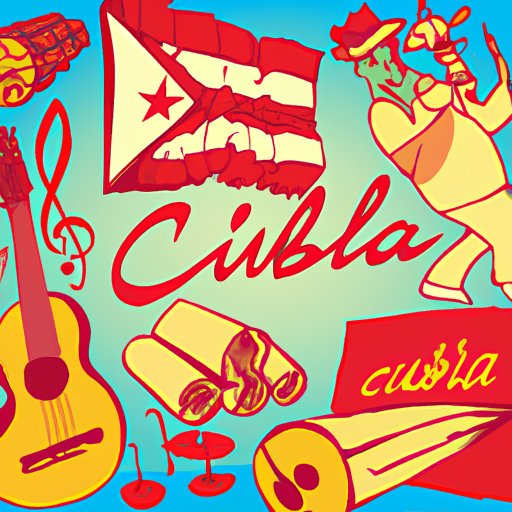Introduction
Cuba is an island nation located in the Caribbean Sea with a rich and vibrant culture. From its music and dance to its art and cuisine, Cuban culture has been heavily influenced by its history, its people, and its environment. In this article, we will explore the many aspects of Cuban culture, from its historical influences to its traditional and popular genres of music and dance, its artistic expression, its traditional dishes and regional specialties, its religious practices, its family values and gender roles, its sports and recreational activities, and its literary achievements.
Exploring the Cultural Heritage of Cuba
Cuba’s cultural heritage can be traced back to its colonial past, when it was colonized by Spain in the 16th century. This period of Spanish rule left a lasting impact on Cuban culture, introducing elements of European culture, including language, religion, architecture, and music. The African slave trade also had a major influence on Cuban culture, bringing with it traditions of music, dance, and art from West Africa. In addition, the United States’ close proximity to Cuba has led to the development of a unique fusion of American and Cuban culture.
A Look at Cuban Music, Dance and Art
Music, dance, and art are integral parts of Cuban culture. Traditional Cuban music includes genres such as son, rumba, and guaracha. Son is a style of music that originated in the 19th century and combines elements of Spanish and African music. Rumba is a lively style of music and dance that originated in Cuba’s Afro-Cuban communities. Guaracha is a popular Cuban musical form that often incorporates humorous lyrics. Popular styles of Cuban music include salsa and reggaeton, both of which have become popular throughout the world.
Cuban art has long been a source of national pride and identity. The country has produced some of the world’s most renowned artists, including Wifredo Lam, Amelia Peláez, and René Portocarrero. Cuban art is known for its vivid colors, bold shapes, and whimsical themes. It often reflects the country’s unique blend of African, European, and Latin American influences.
An Overview of Cuba’s Cuisine
Cuba’s cuisine is heavily influenced by its history and environment. Regional specialties vary from region to region and include dishes such as ropa vieja (shredded beef), congrí (black beans and rice), and plantains. Other typical dishes include tamales, yuca con mojo (yucca with garlic sauce), and arroz con pollo (chicken with rice). Seafood dishes such as ceviche and fish stews are also popular.
Examining Cuba’s Religious Practices
Cuba is a predominantly Catholic country, though there are also significant populations of Protestants, Jews, and practitioners of Santería. Santería is a syncretic religion that combines elements of Catholicism with traditional West African beliefs. It is widely practiced in Cuba and is recognized as an official religion.

Understanding the Role of Family in Cuban Culture
Family is highly valued in Cuban culture, and extended families often live together in close proximity. Gender roles are traditionally defined, with men taking on the role of provider and women taking care of the home and children. However, these roles are becoming less rigid as more and more women enter the workforce.
Discovering Cuba’s Sports and Recreation Activities
Sports and recreation are important aspects of Cuban culture. Baseball is the most popular sport in Cuba, followed by boxing and basketball. Soccer, volleyball, and tennis are also popular. Cubans also enjoy recreational activities such as fishing, swimming, and beach volleyball.

Studying the Impact of Cuban Literature on its People
Cuban literature has a long and illustrious history, spanning centuries of authors and works. Famous authors include José Martí, Alejo Carpentier, and Gabriel García Márquez. Cuban literature has had a profound impact on the country’s culture and its people, inspiring generations of writers and readers.
Conclusion
Cuba is home to a vibrant and unique culture that has been shaped by its history and its people. Through its music, dance, art, cuisine, religion, family values, sports, and literature, Cuba offers a fascinating look into a culture that is unlike any other. By exploring Cuban culture, we can gain insight into the country’s history, its people, and its way of life.
(Note: Is this article not meeting your expectations? Do you have knowledge or insights to share? Unlock new opportunities and expand your reach by joining our authors team. Click Registration to join us and share your expertise with our readers.)
